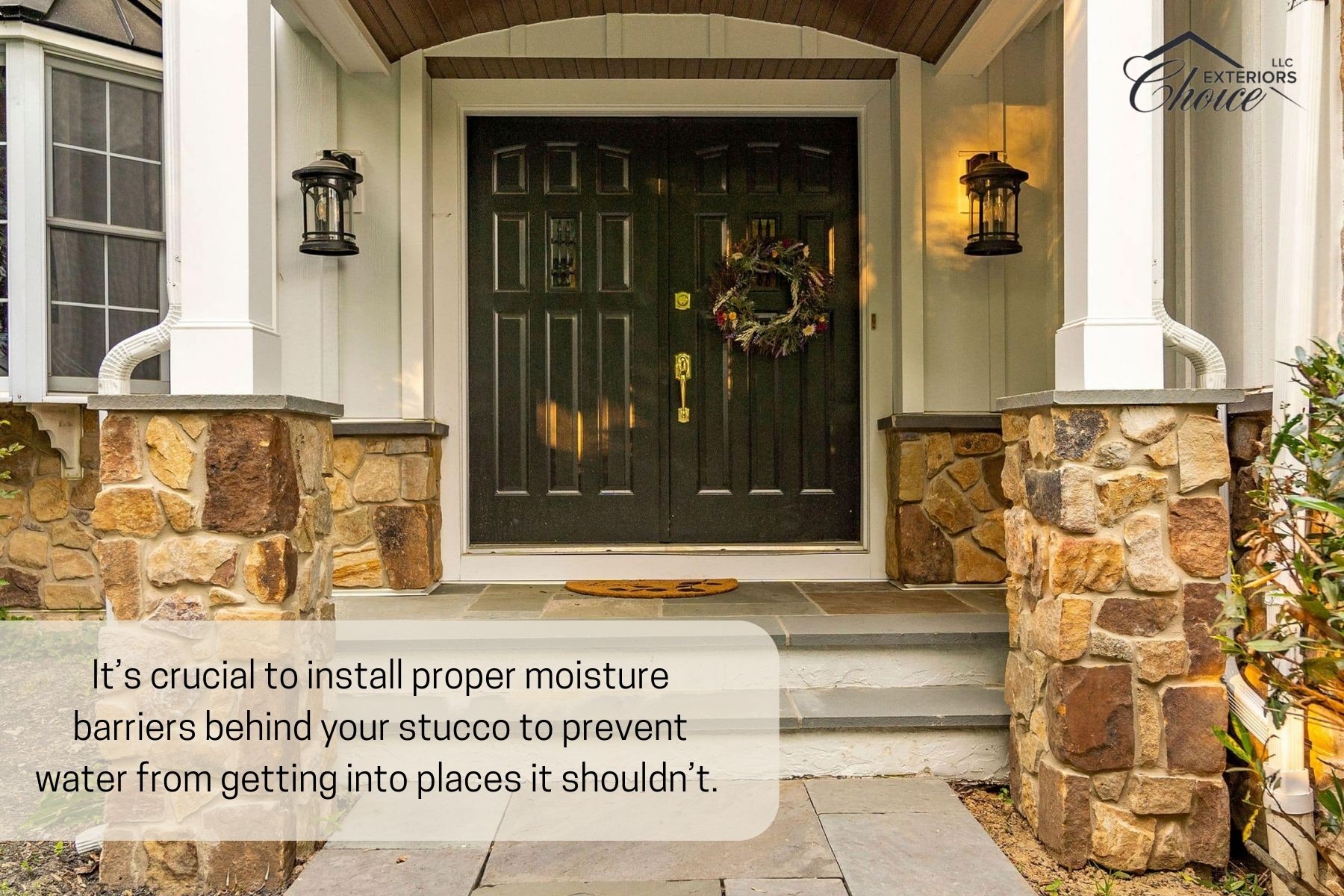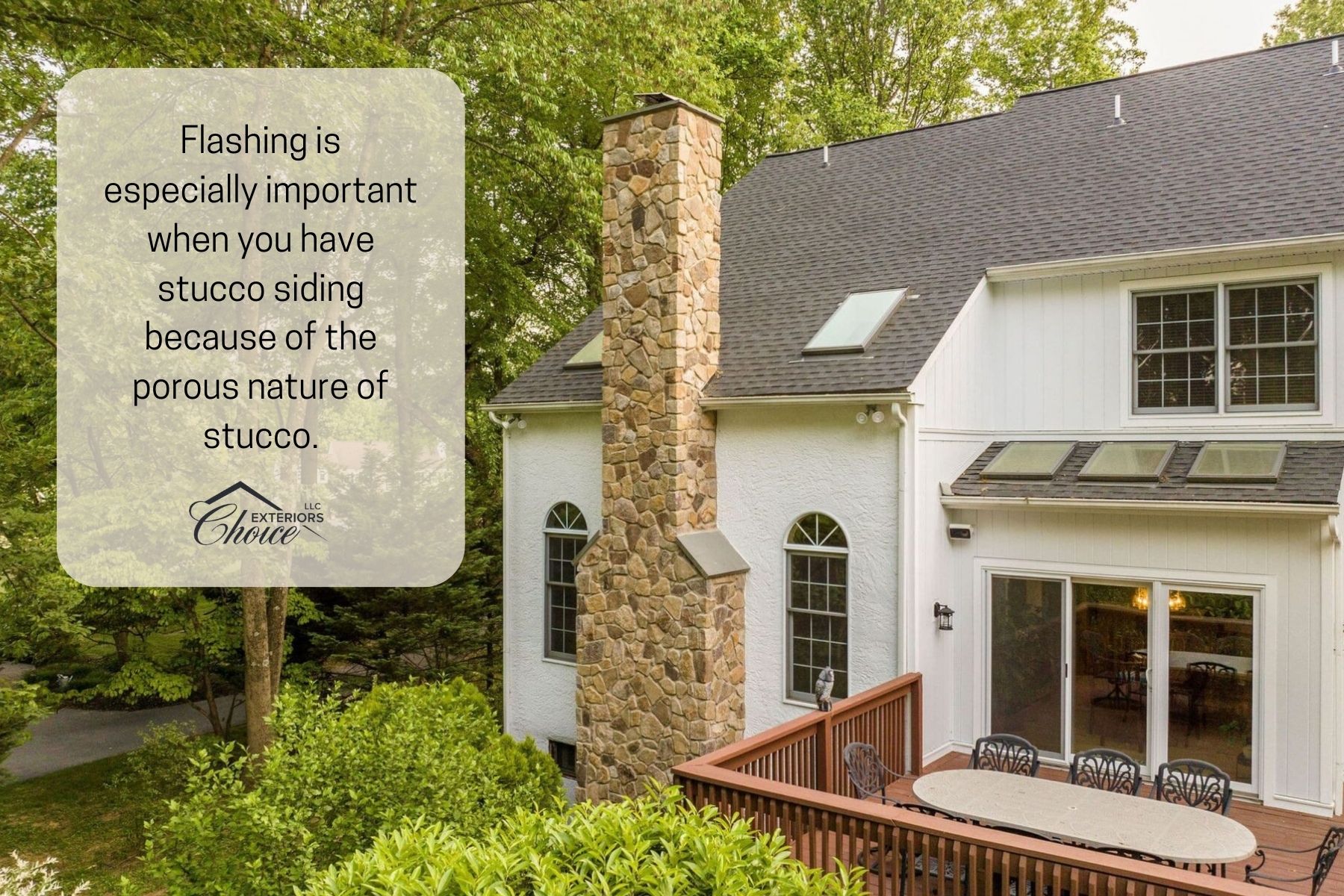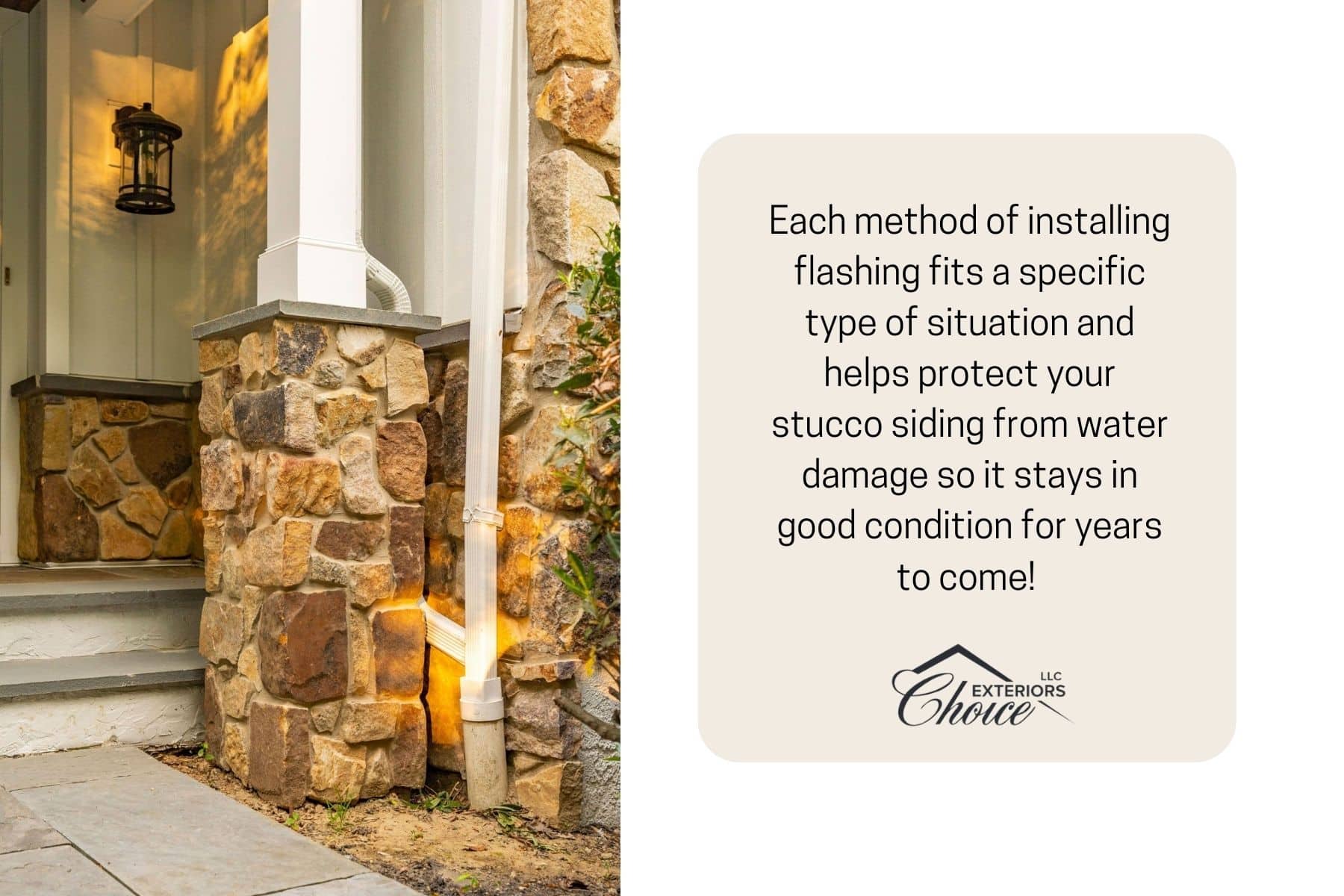Shielding Your Stucco: The Vital Role of Proper Flashing
Stucco is an effective cladding material that can add style and beauty to your home.
However, if stucco siding fails, it becomes a headache and an eyesore!
There are multiple reasons why stucco might fail, and we’ll go over a few of them in this article. One of the most common reasons for stucco failure is poorly installed or malfunctioning flashing.
At Choice Exteriors, we know how vital proper flashing is for stucco function. In this article, we’ll explain what flashing is, what it does, and why it’s so important for your stucco.
Let’s get started!
Why Does Stucco Fail?
Before we talk about flashing, let’s define what stucco is and determine what causes stucco to fail. It’s crucial to understand this so we can understand why flashing is essential for proper stucco function.
Stucco consists of a mixture of cement, sand, lime, and water, which creates a plaster-like material that is then applied to the outside of a building. Once it hardens, it remains in place and provides a hard, weather-resistant layer that protects the building while adding aesthetic appeal.
Because of its porous nature, stucco siding can absorb moisture. This is not normally a problem unless the moisture infiltration becomes excessive or gets behind the stucco and permeates the wooden frame of the building.
Excessive moisture can cause your stucco to crack, crumble, or form mold. And if moisture permeates the wooden parts of your building, it can lead to rotting and serious structural issues.
That’s why it’s crucial to install proper moisture barriers behind your stucco to prevent water from getting into places it shouldn’t.
And that’s where flashing comes in! We are about to dive into what flashing is and why it is so important, so read on to find out!

What Is Flashing?
We’ve discussed how moisture penetration is the main cause of stucco failure.
Now, what is flashing and how does it help keep your stucco looking and performing great?
Flashing is waterproof material installed at the seams and joints of a building to redirect water and prevent it from seeping through the cracks and causing damage.
For instance, flashing might be installed around the following areas:
- Roof-to-wall intersections
- Windows and doors
- Siding
- Decks and balconies
- Exterior walls
- Gutters and downspouts
- Crawl spaces and basements
Properly installed flashing helps redirect water away from these vulnerable areas, preventing it from seeping down and causing damage. This is essential for the longevity of both your stucco siding and building frame.
Why Is Flashing Important?
So why is it so important to have properly installed flashing on your building? And what are the consequences if you have missing or malfunctioning flashing?
It’s like this:
If you don’t have flashing, or if your flashing is improperly installed, water permeates the cracks in your building and gets down into places where it can cause rot, mildew, or even the dreaded black mold.
Over time, this can lead to a general weakening of your structure, or even health hazards (such as that black mold!) This means expensive repairs, decreased property value, or possibly even the destruction of the building.
Flashing is especially important when you have stucco siding because of the porous nature of stucco.

This is because the main thing that causes stucco failure is water seeping in behind it. When water gets behind your stucco, it causes worlds of issues such as cracking, crumbling, and mold. In colder climates, it can even freeze within the stucco and cause bigger issues yet!
Properly installed and maintained flashing prevents water from seeping behind the stucco at critical joints such as around windows and doors. That’s why it’s so essential to the health and longevity of your stucco siding.
How Does Flashing Keep Water Out Of Critical Areas?
Flashing is specifically designed and placed to redirect water away from areas where it could penetrate your building’s structure and cause harm.
Here’s how flashing does its job:
Water diversion
Flashing is shaped and positioned so that water flows over it and is redirected away from joints, cracks, and seams. Water always works its way downwards, so careful placement of flashing can easily redirect it from entering openings in your building.
Overlap and seals
Properly installed flashing is overlapped and tightly sealed around the edges to create a watertight barrier. If your flashing has gaps, it may not be doing much good!
Proper material selection
Using metals, specialized membranes, or treated materials ensures that the flashing remains effective over the long haul and holds up against the elements.
Up next, we’ll talk about some specific flashing materials and types, so stay tuned!
Flashing Materials and Types
We don’t recommend that you ever try installing your own flashing if you don’t have experience with construction–it’s a job for a professional. But just for interest’s sake, let’s look at a few of the materials and methods construction workers use for flashing.
Flashing Materials
There are multiple material types that may be used for flashing, each chosen based on its properties, durability, and suitability for various applications.
Here are some of the most common flashing material types:
- Sheet metal
- Vinyl
- Lead
- Rubber
- Flashing tape
- PVC
Each of these materials has its own set of pros and cons. The choice of material depends on factors such as specific application, climate, budget, and the overall design of the building.
For example, flashing tape is easy to install and is often used around windows and doors. On the other hand, lead (yes, lead flashing is really a thing!) is flexible, malleable, and durable, making it an excellent choice for intricate flashing details that will be exposed to the elements. Don’t worry–lead is perfectly safe when it’s on your roof, where you cannot breathe or ingest it!
Appropriate selection of flashing materials is crucial to ensure effective water management and protect the building from water damage.
Flashing Methods
Depending on where it’s installed, flashing may appear in various ways. For example, here are some common ways to install flashing, depending on the specific situation:
- Stair step method
Often used at roof-to-wall intersections, windows, or doors, the stair-step method involves layering overlapping pieces of metal flashing to create a shingled effect. This resembles stair steps and allows water to flow downward over the flashing.
- Flashing tape
Flashing tape is adhesive-backed, waterproof tape used to seal joints and seams, especially around windows and doors. It’s easy to install and forms an effective moisture barrier.
- Kickout flashing
Kickout flashing is typically found at roof-to-wall intersections, at the eaves. It directs water into the gutter system, preventing it from running down the walls, which could damage stucco over time.
- Through-wall flashing
Designed for areas with high exposure to wind-driven rain, through-wall flashing is installed within the wall cavity, extending from the exterior to the interior of the wall. It provides an additional layer of protection against water penetration for areas that may experience hurricanes or lots of wind-driven rain.
- Drip edge flashing
Drip edge flashing is commonly installed in conjunction with stucco siding to protect the eaves and edges of the roof. It directs water away from the roof’s edge, preventing it from running down the walls.
Each method of installing flashing fits a specific type of situation and helps protect your stucco siding from water damage so it stays in good condition for years to come!

Conclusion
If you own stucco siding, you want it to function properly far into the future!
That is why it’s so important to have quality, well-installed flashing to protect the critical joints on your home’s exterior.
At Choice Exteriors, we know exactly how important flashing is for stucco siding and all other siding types. We use advanced methods for your flashing to ensure no water gets into your home.
If you are looking to improve the style, beauty, and functionality of your home’s exterior, contact us at Choice Exteriors today!
We offer a variety of home exterior services, including:
And more!
Contact us today for all your home exterior needs–we can’t wait to hear from you!





Informative post! Proper flashing is such a critical component of stucco systems, and this article explains it clearly. The emphasis on preventing water damage through proper installation is a great reminder for homeowners and contractors alike.